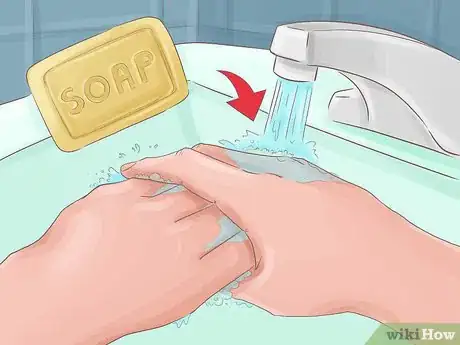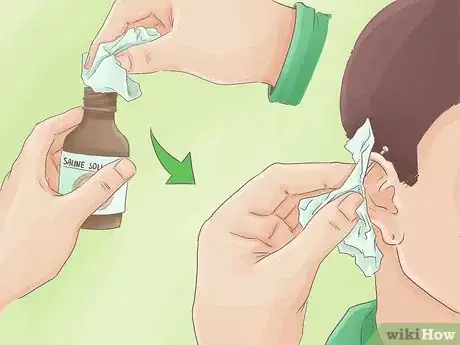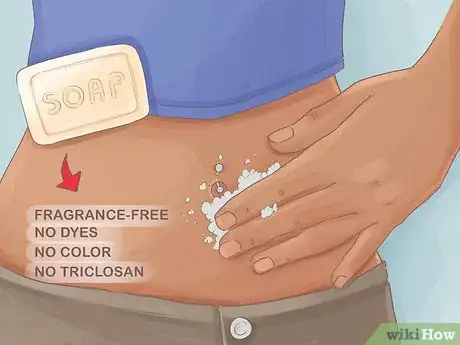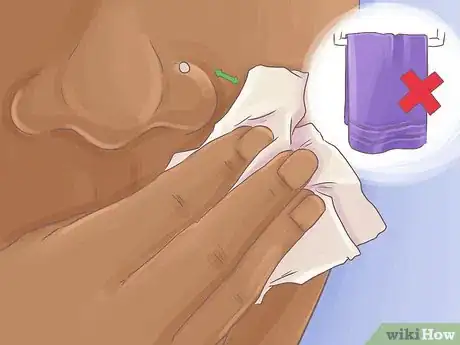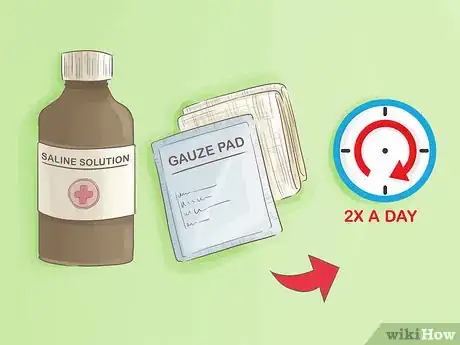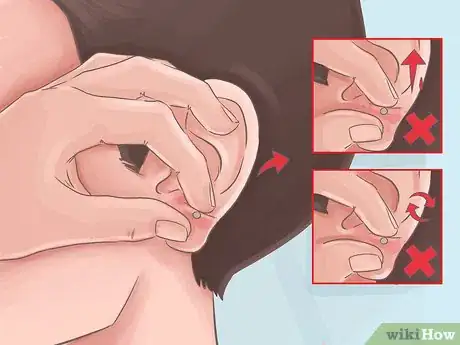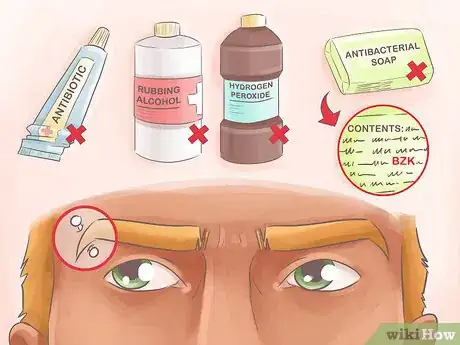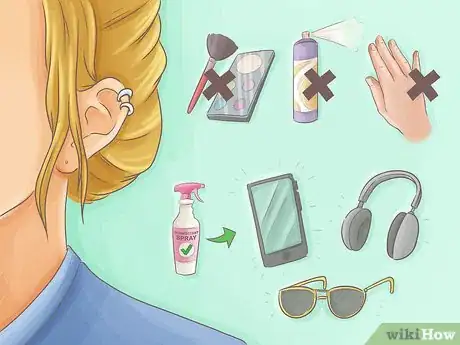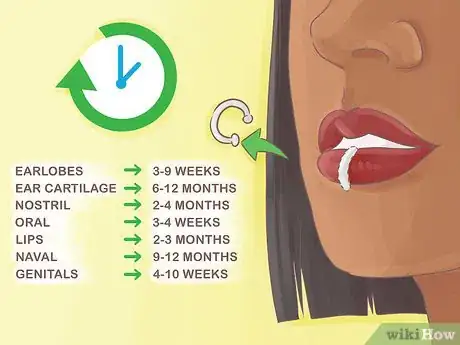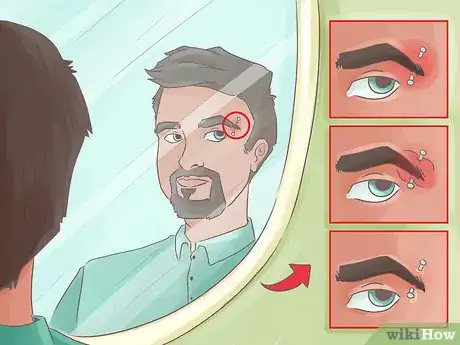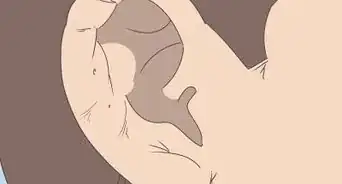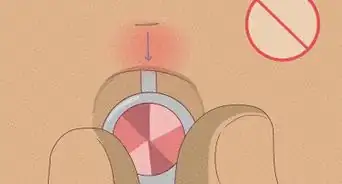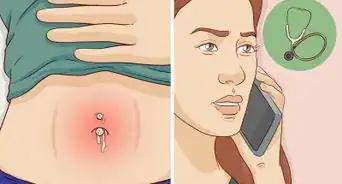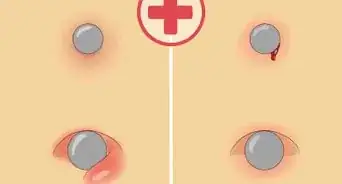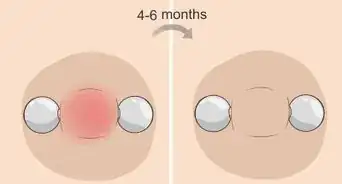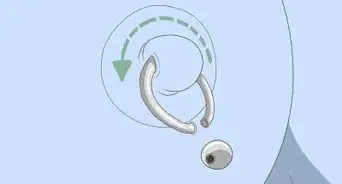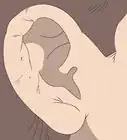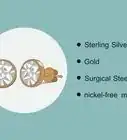This article was co-authored by Sasha Blue and by wikiHow staff writer, Jessica Gibson. Sasha Blue is a Professional Body Piercer and the Owner of 13 Bats Tattoo and Piercing Studio in the San Francisco Bay Area. Sasha has over 20 years of professional body piercing experience, starting with her apprenticeship in 1997. She is licensed with the County of San Francisco in California.
This article has been viewed 601,753 times.
Now that you've gotten your piercing, you're probably ready for it to heal quickly. To speed things up, clean the piercing every day with mild soapy water. Don't irritate the skin around the piercing and avoid reopening the wound, which could slow down healing time. Give the tissue around the piercing plenty of time to heal before you change the jewelry. If you suspect you have an infection, ask the piercer, doctor, or dermatologist if you need antibiotics or if cleaning the site will be enough.
Steps
Cleaning the Piercing
-
1Wash your hands before touching the pierced area. Use mild soap and clean water to scrub your hands clean. Rinse well with clean water before you're ready to touch your skin.
- Avoid letting anyone else touch your pierced area since they could introduce bacteria.
-
2Soak the area in saline for 5 to 10 minutes every day. To keep the area clean, dip a clean gauze pad or paper towels into saline solution. Place the pad over the piercing and hold it there for 5 to 10 minutes. You can do this 1 to 2 times a day.[1]
- Depending on the piercing, you may be able to dip the piercing directly into a cup of saline solution. For example, if you have a finger piercing, submerge your finger in the saline so the piercing is covered.
Advertisement -
3Wash the piercing with soap and water if directed. If your piercer tells you to clean the area with soapy water once a day, wash the skin around the piercing with a fragrance-free mild soap and water. Rinse the area with water to completely remove soapy residue.
- Avoid using soaps with scents, dyes, colors, or triclosan since these will irritate the skin.
- If the piercing is on your ear, remember to wash behind the piercing as well.
-
4Pat the area dry with a paper towel or napkin. Take a clean paper towel or napkin and blot the cleaned skin. Don't apply too much pressure or rub the skin because you don't want to open the wound. Once you're done, throw the paper towel or napkin away.[2]
- Don't use cloth towels because they can become caught or snagged on the jewelry.
-
5Limit how often you clean the piercing to once or twice a day. It might seem like a good idea to frequently clean the area throughout the day, but washing the skin too much can actually wear the tissue down. This will slow down the healing time.[3]
- Wash your piercing after you shower since water will already be getting around the site of the piercing.
Caring for Your Piercing
-
1Leave any crusty scabs in place. Simply soaking the piercing with saline and washing it with gentle soap and water is enough to keep the skin clean. Don't pull or pick at any crusty scabs that form since this can open up the piercing and cause it to bleed. You'll find that the crusty material should fall off on its own as the piercing heals.[4]
- You don't need to turn or twist the jewelry as the piercing is healing. Rotating the jewelry may actually irritate the skin and slow the healing.
-
2Avoid using antibiotics or disinfectants on the piercing. These may irritate the piercing as it's trying to heal. Antibacterial ointments can trap moisture and cause bacteria to grow around the piercing. Disinfectants such as rubbing alcohol or hydrogen peroxide can make it harder for the tissue to heal.
- Avoid using antibacterial soaps or disinfectants that container benzalkonium chloride (BZK).
-
3Keep the piercing site clean and dry throughout the day. Ensure that other people don't touch the area. You'll also need to keep sweat and dirt out of the piercing. For example, don't put makeup or spray fragrances near the piercing. Clean items that might come into contact with the area so you don't introduce bacteria.[5]
- Depending on where the piercing is located, clean your cell phone, headphones, glasses, or hats.
EXPERT TIPSasha Blue is a Professional Body Piercer and the Owner of 13 Bats Tattoo and Piercing Studio in the San Francisco Bay Area. Sasha has over 20 years of professional body piercing experience, starting with her apprenticeship in 1997. She is licensed with the County of San Francisco in California.Professional Body Piercer
 Sasha Blue
Sasha Blue
Professional Body PiercerTry to keep your hands and other objects away from your piercing. Your body wants to heal, so just keep the piercing clean and let it do its thing. While the piercing is healing, try not to play with your jewelry. Also, be careful with your phone and over-the-ear headphones, and try to avoid sleeping on the side with the new piercing.
-
4Give the piercing time to heal before you take out the jewelry. Most piercings will take at least a few weeks or even months to heal. Be patient and give the piercing a chance to heal before you take out the jewelry. Here are a few healing times for common types of piercings:
- Earlobes: 3 to 9 weeks
- Ear cartilage (such as tragus, conch, industrial, rook, or orbital piercings): 6 to 12 months
- Nostril: 2 to 4 months
- Oral: 3 to 4 weeks
- Lips: 2 to 3 months
- Navel: 9 to 12 months
- Genitals: 4 to 10 weeks
EXPERT TIPSasha Blue is a Professional Body Piercer and the Owner of 13 Bats Tattoo and Piercing Studio in the San Francisco Bay Area. Sasha has over 20 years of professional body piercing experience, starting with her apprenticeship in 1997. She is licensed with the County of San Francisco in California.Professional Body Piercer
 Sasha Blue
Sasha Blue
Professional Body PiercerIf you're piercing through cartilage, typically that area will take longer to heal.
Treating Infected Piercings
-
1Recognize signs of infection such as redness, swelling, or fever. While it's normal to feel some pain around the site of the piercing, it's important to pay attention to signs of infection. In addition to pain that doesn't go away or gets worse when you touch the skin around the piercing, other signs of infection include:[6]
- Yellow discharge, green discharge, or blood
- High fever
- Redness, swelling, or a hot sensation
- Persistent itchiness
- Bad odor
-
2See your piercer as soon as you can. Since an infection can become more serious, make an appointment to see the person who did your piercing as soon as possible. In many cases, they can suggest treatments that will resolve the issue without you having to visit the doctor. If your piercer thinks the infection is bad enough to need medical care, they’ll let you know.
- If you or your piercer suspects a severe infection, visit your doctor. The doctor or dermatologist will take your medical history, do a physical exam, and decide the best treatment for you.[7]
- Don't be afraid to go to the emergency room if you think you have a severe cartilage infection. These are trickier to treat and can cause more complications than other piercings.
Tip: It’s easy to mistake symptoms of irritation in a piercing for an infection. Most experienced piercers can help you tell the difference and resolve the issue, which can save you from an unnecessary trip to the doctor.
-
3Ask the doctor if you have a metal allergy. If you suspect that the infection was caused by an allergy to nickel, ask for an allergy skin test. The doctor or dermatologist will test a small patch of your skin to determine if you have a metal allergy. Nickel is the most common metal to cause a skin allergy that leads to infection. The doctor may recommend putting cortisone cream on the area and replacing the nickel jewelry with niobium, titanium, or gold.[8]
- If your allergic reaction is severe, you may have to remove the jewelry and let the hole close. Once the skin heals, you can re-pierce the site, but use a metal you’re not allergic to.
- Even jewelry that is labelled “hypoallergenic” can contain nickel or cause allergic reactions. You should also avoid stainless steel jewelry, which contains nickel.
Community Q&A
-
QuestionMy cartilage piercing is still sore after two months! What can I do?
 Community AnswerCartilage piercings take a long time to heal, this is not unusual. Continue doing proper aftercare.
Community AnswerCartilage piercings take a long time to heal, this is not unusual. Continue doing proper aftercare. -
QuestionWhat is the fastest way I can heal a normal ear piercing? How do I keep it open without having to put an earring in it so it won't close up?
 Community AnswerYou have to have an earing in. There is no way to "keep it open" without having jewelry in to keep it open.
Community AnswerYou have to have an earing in. There is no way to "keep it open" without having jewelry in to keep it open. -
QuestionHelix piercings take up to 9 months to heal, but how long does it take for soreness to go away?
 Community AnswerUsually within 8 - 12 weeks. Soreness should persist, as this is usually the end of the initial healing process.
Community AnswerUsually within 8 - 12 weeks. Soreness should persist, as this is usually the end of the initial healing process.
References
- ↑ https://www.nhs.uk/conditions/body-piercing/
- ↑ https://youngwomenshealth.org/2013/08/07/body-piercing/
- ↑ https://youngwomenshealth.org/2013/08/07/body-piercing/
- ↑ https://youngwomenshealth.org/2013/08/07/body-piercing/
- ↑ https://youngwomenshealth.org/2013/08/07/body-piercing/
- ↑ https://www.nhs.uk/conditions/body-piercing/
- ↑ https://www.nhs.uk/conditions/body-piercing/
- ↑ https://www.nytimes.com/1998/10/20/science/vital-signs-side-effects-when-body-piercing-causes-body-rash.html
About This Article
To heal your piercing, dip a clean gauze pad or paper towel into saline solution and hold it to your piercing for 5 to 10 minutes. Do this once or twice a day until it heals. If your piercer instructed you to clean it with soap, use a fragrance-free mild soap once a day instead. Make sure you rinse the soap off to get rid of any residue. Whichever method you use to clean your piercing, always wash your hands first so you don’t transfer any bacteria to the area. When you’re finished cleaning it, pat your skin dry with a paper towel or napkin to avoid irritating the wound. Remember to avoid picking any scabs that form, since this can cause scarring and bleeding. For more tips, including how to identify signs of infection with your new piercing, read on!
